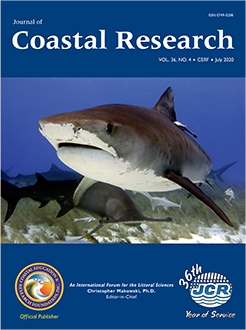Smith, S.M., 2020. Salt marsh migration potential at Cape Cod National Seashore (Massachusetts, U.S.A.) in response to sea-level rise. Journal of Coastal Research, 36(4), 771–779. Coconut Creek (Florida), ISSN 0749-0208.
Salt marshes can adjust to sea-level rise (SLR) through vertical elevation gain and horizontal expansion into terrestrial environments. The latter depends on the topography of adjacent uplands and the availability of suitable substrate for halophyte colonization. Within Cape Cod National Seashore (CCNS), calculations of marsh migration potential in response to 1-m of SLR were completed using ArcGIS (version 10.4) based on real-time kinematic GPS marsh elevations, local tide data, land-use, and upland topography derived from 2011 LIDAR scans of CCNS. These estimates were combined with marsh-loss predictions from a previous study within their present-day footprint under the same SLR scenario. The results suggest that individual marshes will respond quite disparately, as dictated by their position in the tidal frame, adjacent terrestrial slopes, land-use, and barrier-beach losses. Most sites are expected to gain or lose relatively small amounts of marsh area under few or no migration constraints. However, there could be a large increase (∼144–240 ha) at one site and an almost a complete loss at another (∼260–290 ha). Where migration was constrained to slopes ≤1%, opportunities for marsh expansion diminished the most—even more so when barrier-beach losses are simulated. Overall, losses at five marsh sites were offset by gains at Hatches Harbor and Pleasant Bay, Massachusetts, such that the total area of salt marsh actually increases with 1-m of SLR, except under the strictest slope constraints. Changes in the spatial distribution and total extent of salt marsh within the CCNS will influence both the quality and quantity of ecosystem services they provide. For coastal land managers, understanding the potential for overland marsh migration is critical for the kind of land-use planning that accommodates these transitioning salt marshes.





